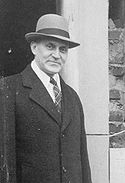-
(b.) -1895 August 06(d.)1983
Bio/Description
He presided over a revolutionary era in the history of the National Weather Service. From 1938 to 1963, he guided the organization through World War II and brought modern technology to weather forecasting. His greatest strengths were in comprehending where meteorology should be going; acting to move in that direction; and then attracting and keeping the talent to make it happen. Born in Harlan, Indiana in 1895, he was the son of a Methodist minister. He worked his way through college, graduating in 1916 from Northwestern University with a degree in chemical engineering. He began a series of experiences and career appointments in the U.S. Navy. During World War I, he became a naval reserve officer in 1916 and was selected for the first class of military personnel for training at the Massachusetts Institute of Technology meteorological school. Afterwards, he was assigned as naval aerographer (a Navy term for meteorologist) and sent to Nova Scotia to brief submarine patrol pilots on weather conditions. Because of his meteorological and aviation experience, he became Chief of Navy Aerology in 1922 and served in that capacity until 1928. He worked in a corner of the main Weather Bureau offices in Washington, D.C., drawing up maps, comparing them to official forecasts, and pondering the weather. The Norwegian Bergen School of Meteorology attracted his attention, and soon he became one of the first American meteorologists to espouse its approach to predicting weather. This approach relied on physical principles for analyzing weather fronts and air masses and not simply weather observations. The Navy assigned him to Bergen, Norway in 1931 for further studies in air mass and frontal analysis. During this period, he made many influential friends, who would later be instrumental in his appointment to lead the Weather Bureau. In September 1938, because of his knowledge of aviation meteorology, possibly his military background (World War II loomed on the horizon), and his familiarity with Bergen methods of weather forecasting, his influential colleagues successfully championed him to head the Weather Bureau. He surrounded himself with scientifically minded individuals such as Carl Rossby, Harry Wexler, and Horace Byers and began pushing the Bureau towards the Bergen methods of forecasting. Soon, however, the Weather Bureau was immersed in World War II. With his naval aerology, shipboard, and aviation experiences, he was the ideal leader to guide the Weather Bureau through its wartime mobilization. He grasped the need for worldwide weather services, helped institute wartime training for hundreds of meteorologists, recruited hundreds of women to replace the men who had entered the armed services, and served on the Joint Meteorological Committee composed of himself and the heads of the Army and Navy weather services. National leaders now viewed weather forecasting, possibly for the first time, as a worldwide strategic imperative affecting the movements of vast amounts of men and material. He quickly grasped the importance of technological advances and soon pursued radar as a weather observation and forecast tool. He advanced the study of climatology by overseeing the production of a forty-year series of carefully analyzed surface maps that showed weather patterns dating back to 1899. After the war, he continued pressing forward, always on the lookout for new methods and new ideas. Continuing advances in radar meteorology, the introduction of computerized numerical weather prediction, and the development of a research arm studying such diverse topics as cloud seeding, severe storms, and patterns of radioactive material dispersal all happened during the 1950s. So did the beginnings of hurricane research programs, the Aircraft Operations Center, the National Severe Storms Laboratory, and the Air Resources Laboratory. Perhaps the greatest of weather observation innovations, the meteorological satellite, was also introduced during his tenure with the launch of TIROS I on April 1, 1960. In ?Turing?s Cathedral? by George Dyson he is seen in a photo of The ENIAC meteorological expedition, Aberdeen Proving Ground, March 1950.
-
Date of Birth:
1895 August 06 -
Date of Death:
1983 -
Gender:
Male -
Noted For:
Instrumental in bringing modern computerized technology, to weather forecasting -
Category of Achievement:
-
More Info:


